The Tribes of Pyrrhia and Pantala
Aug 5, 2019 18:36:39 GMT -7
Post by Ethereal on Aug 5, 2019 18:36:39 GMT -7
Mudwings
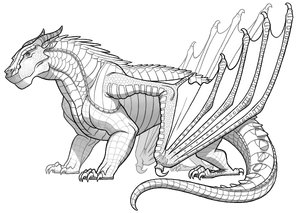
Description: Thick, armored brown scales, sometimes with amber and gold undersides; large, flat heads with nostrils on the top of the snout.
Abilities: Can breathe fire (if warm enough); hold their breath for up to an hour; blend into mud puddles; usually very strong; if hatched from a blood-red egg, they are physically resistant to fire and most extreme sources of heat.
Mudwings are burly, strong, thick-scaled, muscular Pyrrhian dragons who live in the Mud Kingdom. Mudwings have thick, brown, armor-like scales, sometimes with hints of amber or gold in their under scales (which are usually the most obvious in bright sunlight). They have been shown to be dark green like the marsh, a purple-ish color, and even a red color. Their nostrils are located on the top of the snout on a large, flat head so that they can lay submerged in mud for long periods of time. Their eyes have been described as brown, golden-amber, pale amber, or brown with yellow rings around the pupils. They have thick, strong, sturdy, muscular bodies, and closely resemble alligators, crocodiles, and other prehistoric reptiles.
Society: Mudwings lay their eggs in bunk houses that are well protected with warm rocks and covered in mud walls, in a way similar to the real-world crocodilians. This environment is so protected that the mother only has to check on them once in a while; she is often not there during the hatching. The first dragonet to hatch out is often the largest and is known as the bigwings. The bigwings have a natural instinct to help their siblings break open their eggs, and eventually become the leader of the siblings. After the mother covers the eggs, she will never check on them again, or even need to, as it is quite rare for Mudwing parents to care about their dragonets, and the eggs are very safe even if they did. As a result, the bigwings of the group usually becomes the caretaker and parental figure. Mudwings live and work in loyal units with their siblings. They grow up together, learning to hunt and survive and form very close bonds. These groups are often called "sibs" by Mudwings. Pairings are not formal, with a breeding night once a month. Parents do not raise their children, and usually do not know the names of their offspring. Males have no part in caring for their offspring, and neither do the mothers. Often nobody would even know who the father was. A family is comprised of only the siblings. Less wealthy and lowborn Mudwings usually live on the outskirts of Mudwing territory, near the Diamond Spray Delta, while the rest live closer to the center of the kingdom. MudWings live in large mud-and-plant-made sleephouses that house several dragons (usually siblings). Mudwings tend to lay around and nap in large mud puddles and seem to not care how other tribes think of them, as their habitat expresses more of comfort than the need for decoration.
Abilities: Can breathe fire (if warm enough); hold their breath for up to an hour; blend into mud puddles; usually very strong; if hatched from a blood-red egg, they are physically resistant to fire and most extreme sources of heat.
Mudwings are burly, strong, thick-scaled, muscular Pyrrhian dragons who live in the Mud Kingdom. Mudwings have thick, brown, armor-like scales, sometimes with hints of amber or gold in their under scales (which are usually the most obvious in bright sunlight). They have been shown to be dark green like the marsh, a purple-ish color, and even a red color. Their nostrils are located on the top of the snout on a large, flat head so that they can lay submerged in mud for long periods of time. Their eyes have been described as brown, golden-amber, pale amber, or brown with yellow rings around the pupils. They have thick, strong, sturdy, muscular bodies, and closely resemble alligators, crocodiles, and other prehistoric reptiles.
Society: Mudwings lay their eggs in bunk houses that are well protected with warm rocks and covered in mud walls, in a way similar to the real-world crocodilians. This environment is so protected that the mother only has to check on them once in a while; she is often not there during the hatching. The first dragonet to hatch out is often the largest and is known as the bigwings. The bigwings have a natural instinct to help their siblings break open their eggs, and eventually become the leader of the siblings. After the mother covers the eggs, she will never check on them again, or even need to, as it is quite rare for Mudwing parents to care about their dragonets, and the eggs are very safe even if they did. As a result, the bigwings of the group usually becomes the caretaker and parental figure. Mudwings live and work in loyal units with their siblings. They grow up together, learning to hunt and survive and form very close bonds. These groups are often called "sibs" by Mudwings. Pairings are not formal, with a breeding night once a month. Parents do not raise their children, and usually do not know the names of their offspring. Males have no part in caring for their offspring, and neither do the mothers. Often nobody would even know who the father was. A family is comprised of only the siblings. Less wealthy and lowborn Mudwings usually live on the outskirts of Mudwing territory, near the Diamond Spray Delta, while the rest live closer to the center of the kingdom. MudWings live in large mud-and-plant-made sleephouses that house several dragons (usually siblings). Mudwings tend to lay around and nap in large mud puddles and seem to not care how other tribes think of them, as their habitat expresses more of comfort than the need for decoration.
Names: Mudwing names generally relate to the earth, swamps and the things that reside there such as Reed, Crane, Pheasant, Sora, and Cattail, or shades of brown, such as Umber, Sepia, and Ochre. Sometimes they can also be named after types of diamonds or minerals, such as Asha, possibly because they form in areas with mud or because of the Diamond Spray Delta, or synonyms of swamps or swampy areas such as Marsh, Swamp, and Bog.
Sandwings


Description: Pale yellow or white scales the color of desert sand; poisonous barbed tail; forked black tongues; eyes black as onyx.
Abilities: Can survive a long time without water; poison enemies with tips of tails like scorpions (the cure for this venom is a certain cactus); bury themselves for camouflage in the desert sand, breathe fire.
Sandwings are a desert-dwelling tribe of Pyrrhian dragons whose scale pigmentation ranges from pale gold, light yellow, off-white, and pale brown. They can breathe fire much like other Pyrrhian dragon tribes. Sandwings can also survive for long periods of time without water, and poison their victims with the tips of their venom-barbed tails, which are quite similar to a scorpion's. All Sandwings have heat-radiating scales. Some Sandwings have been described with brown speckles on their wings and snouts, similar to human freckles. Their snouts tend to be short and compact, with a nose-spike, and a smaller horn under their ear. Some can also have black diamond patterns on their scales. They have a ridge going from their head and about 3/4 of their tails, forked black tongues, glittering black eyes, and are armed with venomous, scorpion-like barbs on the end of their tails. Sandwings seem to walk on their toes. Some Sandwings have been shown to have tattoos.
Names: Sandwings are the dragons of the desert habitat, hence their names. The flora, fauna, and landscape of both deserts and savannas are used as dragon names in the tribe. They may also have names relating to fire or heat. Sandwings have been known to name themselves after black colored gemstones as well.
Seawings

Description: Blue or green or aquamarine scales; webs between their claws; gills on their necks; bioluminescent stripes on their tails/snouts/underbellies. Royal SeaWings have large swirls and starbursts under their wings.
Abilities: Can breathe underwater; have bioluminescent stripes behind their eyes and on their bodies (which give them their own language, called Aquatic); create huge waves with one splash of their powerful tails; excellent swimmers (animus power runs in the royal family).
Seawings are finned, gilled, ocean-dwelling Pyrrhian dragons with bioluminescent scales that cover their underbellies, snouts, backs, and tails. They can see in the dark and can make large waves with their tails. Seawings commonly range from a scale color of blues, greens, aquamarine, teal, and rarely yellow or indigo. Sea2ings usually have green or blue eyes, with some exceptions having grey-green eyes. The Seawings have webbed talons with hooked claws, as well as long, powerful tails, which makes them excellent swimmers, and can be used for self-defense. They have gills on the side of their necks that allow them to breathe underwater. Seawings are considered small, in height, and have long, compact bodies with short legs. They have curved horns, a slender and curved snout, and have two short tendrils coming from the bottom of their chin, which could possibly help with blending into their environment or simply just a decoration. They have webbed spines along their chest and along the backs of their necks to the tips of their tail. Seawings also have their powerful tails to propel them through the water. Like all dragons, they have five claws on their front talons and four on their back talons. The bioluminescent stripes on a Seawing's body are used to attract other Seawings when choosing their mates, or during Aquatic conversation, which is the only way for Seawings to communicate underwater using patterns of glowing scales. Members of the royal family have light blue spiral markings as well as starbursts on the underside of their wings. Non-Royal Seawings don't have any starbursts or patterns on their wings.
Names: Some Seawings are named after sea-related items or wildlife like Nautilus, Anemone, Orca, Tsunami, Shark, Snail and Turtle. They also have names related to shades of blue colors, like Indigo. Some may have names of gems that have Seawing colors, like Sapphire. They can also have names relating to Seawing anatomies, like Webs or Gill.
Names: Some Seawings are named after sea-related items or wildlife like Nautilus, Anemone, Orca, Tsunami, Shark, Snail and Turtle. They also have names related to shades of blue colors, like Indigo. Some may have names of gems that have Seawing colors, like Sapphire. They can also have names relating to Seawing anatomies, like Webs or Gill.
Skywings


Description: Red-gold, orange, and sometimes pink scales; enormous wings.
Abilities: Powerful fighters and fliers; can breathe fire (Some are born with firescales).
Skywings are characterized most by their warm-toned scales and enormous wings, and most Skywings have been noted to be skilled fliers. They are also one of the four tribes that can breathe fire, but are the one tribe exclusive to a rare and dangerous condition called firescales in which the affected dragon has abnormally hot scales and will burn through/and or light on fire anything they touch. Typically, Skywings have red, pink, orange, or golden scales with yellow, orange, or amber eyes. Their scales have been described to be "jewel-hard". Skywings have enormous wings, larger than any other tribes, attached to their bodies by their shoulder bones. It has been implied that Skywings have a strong respiratory system, probably because of their constant high-altitude environment. Most Skywing snouts are thin and long, with a nose-spike, and an extra horn on their jaw. Their horns are long, thin, and curved.
Names: Skywings tend to name their young after sky or mountain-related environments and creatures, such as birds, things occurring or features on mountains, as well as natural sky phenomena, and since the Skywings seem to be based on the element of fire, fire-related names, and minerals and gems. They can also be named after shades of red or red gemstones.
Rainwings

Description: Scales constantly shift colors, depending on their mood. Usually bright like birds of paradise; prehensile tails. Some scale colors include pink for happiness, pale green for fear, white for pain, red for anger, blue-purple for pride, deep purple for guilt or shame, and blue-gray for sadness.
Abilities: Can camouflage their scales to blend into their surroundings; shoot a deadly black venom from their fangs, which destroys all living material and kills within minutes if it gets in the eyes or bloodstream (for which the only cure is venom from a related dragon); can imitate a bird call perfectly.
Rainwings are peaceful, pacifist Pyrrhian dragons who currently reside in the Rainforest Kingdom. They are able to spit deadly black venom that can severely injure or kill any living thing from their two front most fangs. They have the ability to travel through the rainforest quickly by swinging from their prehensile tails, and are able to change their scale color based on their mood, their environment, or by intention. A Rainwing's scales will generally change color according to their mood, whether they want that color or not. Most natural colors Rainwings may change into are bright, like the rainforest, yet it is not their only color palette, as they can change their scales to an uncanny resemblance to any tribe. Although they can control their scales, they can have a hard time stopping emotions, particularly powerful ones, from coming through. When a Rainwing's fear is very strong, they will turn pale green, gray and white and are unable to camouflage or change their scales. Rainwings are long and graceful, with a ruff behind their ears and prehensile tails that are used primarily for climbing trees and hanging in the rainforest they inhabit. When afraid or insulted, or angry, Rainwings flare their ruffs, possibly as a defense tactic, to seem bigger or to scare away others, similar to that of the frilled lizard.
Society: Rainwings are seen as lazy and unintelligent due to their tendency to lay around in the sun, although the sun's rays have a positive effect on their bodies, making them prettier, smarter, more positive, better at camouflage, and even less hungry. They appear to have a carefree society with almost no conflict; there is plenty of food, so they have no reason to fight. The adults don't even bother to watch or count the eggs. The Rainwings all care for the dragonets together and drop by the hatcheries once every few days to pick up any new dragonets. They have crude blowguns, loaded with darts coated in tree-frog poison, in which they call "sleeping-darts". They are used for playing games or when strange dragons wander into the forest. The darts they used seem to immediately render the target dragon unconscious, although sometimes the effect takes a minute or two to set in. Rainwings also keep and take great care of pet sloths. Since the pets from other tribes are usually eaten or lost by mistake, this shows Rainwings can be both caring and soft, and further highlighting their peaceful nature.
Names: Rainwings tend to name their dragonets after rainforest animals, such as Kinkajou or Tamarin, plants, such as Jambu, Mangrove, or Orchid, fruits such as Banana or Coconut, and adjectives, such as Exquisite, Dazzling, or Magnificent.
Icewings
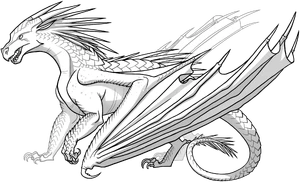
Description: Silvery scales like snow or pale blue like ice; ridged claws to grip the ice; forked blue tongues; tails narrow to a whip-thin end.
Abilities: Can withstand sub-zero temperature and bright light; exhale a deadly freezing breath.
Icewings are a tribe of Pyrrhian dragons with scale colors that vary from different shades of white, gray, silver, pale blue, or light purple. Icewings are equipped with lethal frostbreath, whip-thin tails, serrated claws, and the ability to withstand subzero temperatures. An Icewing's scales can range from silvery white colors to pale shades of blue and purple. Their coloring has been described as "silver like the moon", "pale blue like ice", "as pale as the moons," or "scales the color of sky reflected in the snow on the distant mountain peaks", and sometimes "moon white scales." The head of an Icewing is shaped like a diamond and is very narrow, with spikes going down their head and body. They are lean dragons that also have surprisingly strong but narrow, whip-like tails with extra icicle-shaped spines, being very sharp at the tip of the tail. Icewings have blue, black, or stormy grey eyes, forked blue tongues, and ridged, serrated claws to grip the ice while traveling by talon around their habitat. They have also been noted to have dark blue blood, unlike the normal dark red blood of the other Pyrrhian tribes. Their claws are described to feel "four times sharper than average claws" due to them being serrated. Some Icewings have been described to have dark blue or purple freckles or markings on their faces and wings.
Society: The Icewings appear to be fairly sophisticated in comparison to the other tribes, being the only dragons to have social classes. The aristocracy of the Icewing tribe is divided into seven ranks, or circles, of status, with the First Circle being the best and the Seventh Circle being the worst. They separate dragonets and adults into two different divisions. Before their seventh hatching day, Icewing dragonets climb up the ranks by hunting, training, performing the proper Icewing customs impeccably, and surpassing various tests given by the dragonets' parents or guardians. The current rank possessed by the dragonet on their seventh hatching day determines the course of the rest of his or her life, although adult dragons are still capable of dropping or gaining circles. Dragonets who were ranked in a high-ranking circle are housed in the queen's palace when they are adults and are granted input on important political and tribal matters as well. Icewings tend to be very proud, stiff, and arrogant dragons. Tribal pride isn't a secret among the Icewings, and thus their tribe consists of very haughty and uptight individuals. On the rare occasion that an Icewing interacts with a member of another tribe, it's usually very formal and forced; the Icewings believe that their tribe is superior to any other and that the other tribes are just a footnote in the great Icewing sagas that told the history of Pyrrhia. Thus, the entire time they're talking to someone, it's usually with disdain.
Names: Icewing names are chosen by the family member with the highest rank and must be approved by the queen. They can be named after ice formations such as Glacier, arctic animals (terrestrial or aquatic) such as Narwhal and Ermine, words for "white" in various languages such as Hvitur, polar landscapes such as Tundra, and polar weather such as Hailstorm. Also, it is possible for them to be named after blue and white gemstones such as Diamond.
Nightwings

Description: Dark, midnight black scales with scattered silver scales on the underside of their wings, like a night sky full of stars; forked black tongues.
Abilities: Can breathe fire; disappear into dark shadows, some hatch with the power to read minds or tell the future. If a Nightwing hatches under one full moon, they get either mind reading or future sight, two full moons indicate both, and the rare three moons show that the dragonet is going to have powerful mind reading and the power to see all possible futures.
Nightwings have forked, black tongues and have dark scales, which are usually black, dark blue or purplish-black scales with silver, purple, dark green, and silvery, purple or blue underbellies (mind readers have silver teardrop scales by the corners of their eyes). They have been described with black, blue, purple, or green eyes. The undersides of their wings are always black and speckled with silver scales that give them the appearance of a night sky filled with twinkling stars, allowing them to fly at night without detection. Nightwings were once most active at night and tended to sleep during the day, but their nocturnal sleep schedule had been changed due to two thousand years of living on the volcano, so they now sleep at night, like the other dragon tribes. Nightwings are also known to be able to hang "from crags and rocks and ceilings like bats."
Society: Nightwings form lifelong partnerships, similar to Seawings. Their dragonets live in dormitories located in caves on the sides of the volcano. Nightwing names are very literal, although sometimes ironic. These dragonets are usually named according to their talents. Complete loyalty seems to be an emphasized Nightwing trait, as many of their actions point towards a "blind loyalty" to their tribe, the willingness to do anything for their tribe, even wiping out another tribe of dragons.
Names: Nightwing names can be compound words that describe Nightwing powers, such as Fatespeaker and Mindreader. The names can also describe the dragon's personality or ability, such as Mastermind and Quickdeath. Descriptive words, such as Thoughtful, Vengeance and Listener, are used as well, as are night-themed compound words such as Starflight and Moonwatcher.
Hivewings
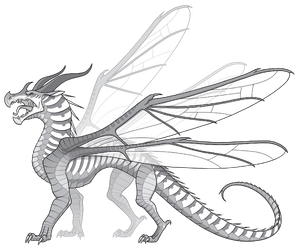
Description: Red, yellow, and/or orange, but always mixed with some black scales; four wings.
Abilities: Vary from dragon to dragon; examples include deadly stingers that can extend from their wrists to stab their enemies; venom in their teeth or claws; a paralyzing toxin that can immobilize their prey; or boiling acid sprayed from a stinger on their tails, and in some cases, the ability to emit a disgusting smell.
Hivewings are one of the three tribes that live on Pantala. Hivewings are the tribe that currently has control of most of Pantala, as they killed off most of the Leafwings and took over the Silkwings. Hivewings have slender, incredibly strong and muscular bodies, with four thin and clear segmented wings. Hivewings can be red, yellow, and/or orange, but always have some black scales. The common belief among Hivewings is that the reason why they have black scales because they share the same ancestor, Clearsight. Hivewings have a slightly compact face, with a smaller nose-ridge on the tip of their snout, and a larger curved ridge on their forehead. Some Hivewings have freckle-like scales. Confirmed eye colors include black, brown, red, and green. They have a pair of long, curved, and smooth-looking horns, that raise slightly above their head, the tips curving slightly forward, giving them an almost regal appearance. Long thin spikes go down their spines, to the tip of their tails, which have a slightly larger spine, which can be used to spray acid or inject venom, alongside spikes on their wrists used for similar purposes.
Society: Hivewings are first class citizens in their society. They live in Hives ruled by the Queen and her female relatives. Unlike other dragons tribes in both Pantala and Pyrrhia, the Queen's relatives who rule the other Hives aren't titled as Princess, but Lady (the female term for lord). However, the Queen still outranks the Ladies. It's also difficult for Hivewings to get a divorce because they need permission from the Queen in order to do so. If the Queen allows a Hivewing couple to get divorced, they have to go through a whole separation request process. It's unknown what kind of work Hivewings need to do in order to become divorced but the process is difficult. Hivewings who become mates without the queen's approval are severely punished.
Names: The Hivewings are named after a variety of insects. Dragons from the tribe can be named after different species of bee and wasp, but also any other insects that aren’t related to Silkwings, like ants, beetles, weevils, crickets, praying mantis, and more. They can also be named after types of annelids (Earthworm and Bloodworm).
Silkwings
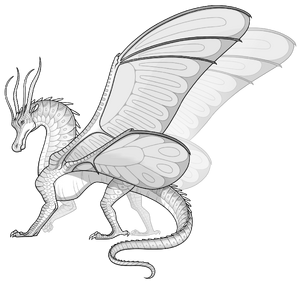
Description: Silkwings dragonets are born wingless, but go through metamorphosis at age six, when they develop four huge wings and silk-spinning abilities; as beautiful and gentle as butterflies, with scales in any color under the sun, except black. Some Silkwings develop flamesilk when they go through metamorphosis, which is where their silk is fire.
Abilities: Can spin silk from glands on their wrists to create webs or other woven articles; can detect vibrations with their antennae to assess threats.
Silkwings have two pairs of wings, one pair smaller than the other, with membranes that have rounded edges. While Pyrrhian dragons have bat-like wings, Silkwings have insect-like wings, which can be compared to butterfly wings in design and shape, as well as appearing to be translucent. Their wings also have spots on their inner membranes. The bigger pair of wings appears to have four or five digits that the membrane is stretched between. The smaller pair of wings attach in front of the larger pair, in the armpit area, and have two or three digits. Silkwings appear to have plated scales and have small spines running down their back, to the tip of their tail. Their scales appear to be somewhat iridescent, similar to Nightwing scales. They have long and slim bodies, similar to Rainwings. Their horns are curved, almost Rainwing-like in shape, but much thinner. There is also a set of antennae on the brow, just above the eyes. The ridge above their eyes runs over their horns, giving SilkWings a plated appearance. Silkwings can be any color except black, such as olive green, aquamarine, lavender, indigo, amber, orange, dark purple, grey, and red. Most Silkwings seem to have iridescent scales. The wing membranes appear to be different colors too, as well as certain segments between the digits being a different color than the rest of the wing.
Society: Silkwings had been living in 'cells' ever since Queen Wasp took over their tribe. Under Wasp's rule, Silkwings are second class citizens and have fewer rights than Hivewings. One example is getting divorced. Unlike Hivewings who need the Queen's permission to get a divorce, Silkwing couples have to remain together until the queen orders a divorce. The Hivewings also choose who Silkwings marry.
Names: Silkwings are usually named after different species of butterfly and moth, although a few have been named after species of dragonfly. They have also been known to be named after colors, like Blue and Orange. Since it was confirmed Silkwings were also based off of beetles and spiders, it is possible that some future Silkwing characters could be named after those species as well.
Leafwings
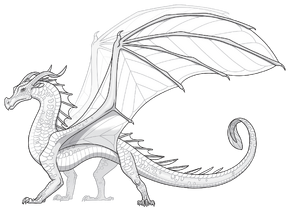
Description: Thought to have been wiped out during the Tree Wars with the Hivewings but actually aren’t. This tribe has green and brown scales and wings shaped like leaves.
Abilities: Can absorb energy from sunlight and are accomplished gardeners; some are rumored to have unusual control over plants.
Leafwings have green and brown scales on their body, along with leaf-like patterns. They appear to have webbed spines, along their neck and back, similar to a Seawing's. The webbing along their back splits into individual pieces near the base of the tail, which are shaped like leaves. Their snout is slightly curved, similar to a Skywing's, with a raised ridge on the tip of their snout. They also have a flat tail, ending in a leaf shape. Their wings are also leaf-like, and slightly transparent, with leaf veins in the webbing and their wings in the form of branches, complementing their name. The edges of their wings are rounded, giving it a very leaf-like look. Their horns appear to be skinny and flat-ended, almost like leaves. The scales atop their eyes go over the top of their horns, giving it a partially plated look. Their scales are uneven, vaguely resembling chloroplasts and plant cells. They have a plated underbelly and a slender body shape. Their legs seem to be slightly short and thin. Their eyes can be orange-gold, blue, green, or purple.
Names: Leafwings are named after different types of trees, plants, flora, etc, that are found in forests and woods.
All information here is sourced from the wiki. Feel free to explore yourself to learn more!


